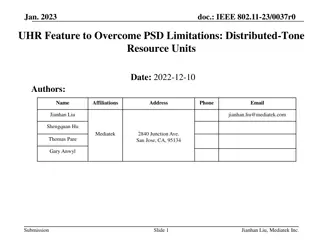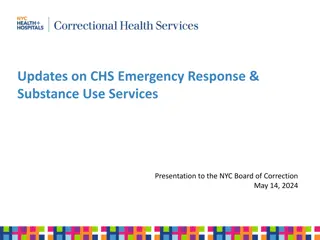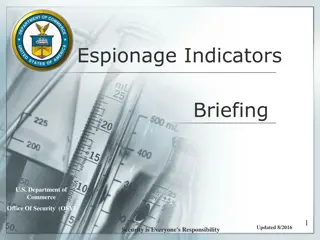
Understanding Human Rights and Medical Ethics Through Historical Context
Explore the significance of human rights and medical ethics through a historical lens, tracing back to World War II and addressing ethical violations such as the Tuskegee Syphilis Experiment. Learn about the foundation of human rights, the role of the United Nations, and the integration of ethical principles in medical practice.
Download Presentation

Please find below an Image/Link to download the presentation.
The content on the website is provided AS IS for your information and personal use only. It may not be sold, licensed, or shared on other websites without obtaining consent from the author. If you encounter any issues during the download, it is possible that the publisher has removed the file from their server.
You are allowed to download the files provided on this website for personal or commercial use, subject to the condition that they are used lawfully. All files are the property of their respective owners.
The content on the website is provided AS IS for your information and personal use only. It may not be sold, licensed, or shared on other websites without obtaining consent from the author.
E N D
Presentation Transcript
Human Rights and Medical Ethics Jeff Bedard, MSc October 22, 2021
Introduction A little about me: Nearly 25 years in the medical device and pharmaceutical industries Started as a medical device representative-in surgery everyday M-F - and then moved into the pharmaceutical industry Currently work as a consultant for a multinational pharmaceutical company What I do-project management, operations and quality assurance. I work with Operations, Global Medical Affairs, Quality Assurance, Compliance/Regulatory and Information Technology What I love-every day is different
Human Rights-what are they? The United Nations defines human rights as rights inherent to all human beings, regardless of race, sex, nationality, ethnicity, language, religion, or any other status. Human rights include the right to life and liberty, freedom from slavery and torture, freedom of opinion and expression, the right to work and education, and many more. The roots of human rights lay in the traditions and documents of many cultures. The Hindu Vedas, the Bible, Code of Hammurabi, the Quran, Iroquois Constitution, Inca & Aztec codes of conduct were all early sources addressing the roles, rights and responsibilities of individuals. The documents that laid the foundation for many of the principles of individual and human rights as we know them today are the Magna Carta (1215), the English Bill of Rights (1689), the French Declaration on the Rights of Man and Citizen (1789), and the US Constitution and Bill of Rights (1791)
Human Rights-what are they? The events of World War II propelled human rights onto the global stage and into the global conscience. War crimes trials were held in both Germany and Japan following World War II to address the crimes against humanity As a part of the Nazi extermination camps, medical experiments were conducted on prisoners without their consent. Out of the Nuremberg Trials, the tribunal laid down 10 standards to which physicians must conform when carrying out experiments on human subjects in a new code that is now accepted world. The principles established by this code for medical practice now have been extended into general codes of medical ethics. Following WWII, the United Nations was created, and the Universal Declaration of Human Rights (UDHR) was adopted by the UN General Assembly in 1948, was the first legal document to set out the fundamental human rights to be universally protected.
Human Rights and Medical Ethics: The Tuskegee Experiment Although formal ethical frameworks were put in place in the United States, there have been significant ethical violations in medicine. The Tuskegee Syphilis Experiment: In 1932, the US Public Health Service, working with the Tuskegee Institute, began a study to record the natural history of syphilis. The study initially involved 600 Black men 399 with syphilis, 201 who did not have the disease. By 1943, penicillin was the treatment of choice for syphilis and becoming widely available, but the participants in the study were not offered treatment. Participants were left untreated until 1972 when a story was published by the Associated Press. It wasn't until 1997 that President Bill Clinton issued a formal apology.
Human Rights and Medical Ethics: Eugenics In 1907, Indiana became the first state in the country to successfully pass a mandatory forced sterilization law impacting the "feebleminded," a term used at the time to refer to people with cognitive challenges. In 1927, The U.S. Supreme Court ruled 8-1 in Buck v. Bell that laws mandating the sterilization of the mentally handicapped did not violate the Constitution. Justice Oliver Wendell Holmes made an explicitly eugenic argument in writing for the majority: It is better for all the world, if instead of waiting to execute degenerate offspring for crime, or to let them starve for their imbecility, society can prevent those who are manifestly unfit from continuing their kind. Nazi propaganda defended Germany's forced sterilization program by citing the U.S. as an ally in the eugenic movement. World War II and the atrocities committed by the Nazi government would rapidly change U.S. attitudes towards eugenics.
Human Rights and Medical Ethics: Eugenics The Nixon Administration dramatically increased Medicaid-funded sterilization of low-income Americans, primarily those of color. While these sterilizations were voluntary as a matter of policy, anecdotal evidence later suggested that they were often involuntary as a matter of practice. Patients were frequently misinformed or left uninformed regarding the nature of the procedures that they'd agreed to undergo 1981 is commonly listed as the year in which Oregon performed the last legal forced sterilization in U.S. history. However, forced sterilizations have continued in more recent years. For instance, according to a report by The Guardian, California has been forcibly sterilizing people (in this case, in prisons) as recently as 2010; the state approved a budget in 2021 for reparations to those who were sterilized without consent.
Medical Ethics/Bioethics What is it? It deals with the ethical implications of medical treatment & research and biological research on patients and animals. Ethical frameworks: in addition to personal moral/value systems, healthcare professionals also rely on a code of ethics. Some examples: American Medical Association Principles of Medical Ethics https://www.ama- assn.org/sites/default/files/media-browser/principles-of- medical-ethics.pdf American Nurses Association Code of Ethics: https://www.nursingworld.org/coe-view-only
Bioethics, cont. Ethics committees-assist healthcare providers and institutions in making ethical decisions around a difficult cases. https://www.pantagraph.com/lifestyles/health-med- fit/ethics-committees-help-with-life-death- decisions/article_18ce6a4e-fad1-11e2-bfa8-0019bb2963f4.html One of the tools that assist bioethicists in making decisions is called the 4 Box Analysis It contains a list of questions that should be addressed in order to assist in making the best decision for that patient.
Bioethics-case study A forty-five-year-old man with a three-year history of cardiovascular disease has entered the hospital with a stroke that has paralyzed his right side and caused him to aspirate food of any consistency. His mental status is clouded and there is disagreement as to whether he has decisional capacity. His language capacity is only yes and no, and his responses are inconsistent. The attending physician is convinced that the patient has lost decisional capacity while two family members are equally convinced that he has decisional capacity. The patient s wife and two other children are ambivalent about his competency to make decisions. The prognosis for recovery of safe swallowing and speech approaches zero because of the dense damage to the cerebral cortex visible on brain imaging. Two neurological consultants have verified that recovery is likely to be minimal and that permanent, severe disability will be the outcome. The patient does not have an advance directive. The patient s wife says that they never did discuss his preferences about life-sustaining treatment. She is convinced that he would not want to live in this disabled condition but is uncertain whether to request the placement of a feeding tube. Two of her four adult children are strongly opposed to the tube placement, while the other two insist that not to do so would be to kill our father. The patient s wife is torn between these two positions, but finally requests that the tube be placed. The attending physician and the rest of the treatment team are opposed to placing the feeding tube. Their argument is that the patient has minimal consciousness and will not improve. They define this as a futile situation with no reasonable expectation of recovery. Furthermore, two nurses claim that during previous hospitalizations for episodes of cardiovascular events the patient told them that he would not want to be sustained by artificial means not by ventilators, renal dialysis, or tube feeding. It is their position that the patient has expressed his preference to not be kept alive in a futile situation. The family requests an ethics consultation.
Bioethics-questions Landmark legal cases with bioethical implications https://www.practicalbioethics.org/files/case- studies/Guide-for-Ethics-Committees-Part-1.pdf https://www.practicalbioethics.org/files/case- studies/Guide-for-Ethics-Committees-Part-2.pdf https://www.cdc.gov/tuskegee/timeline.htm
Bioethics Books Bestselling books on bioethical issues: The Immortal Life of Henrietta Lacks by Rebecca Skloot The Diving Bell and the Butterfly: A Memoir of Life in Death by Jean-Dominique Bauby (Jeremy Leggatt-Translator) Medical Apartheid: The Dark History of Medical Experimentation on Black Americans from Colonial Times to the Present by Harriet A. Washington Killing the Black Body: Race, Reproduction and the Meaning of Liberty by Dorothy Roberts The Adoration of Jenna Fox (Jenna Fox Chronicles, #1) by Mary E. Pearson





















